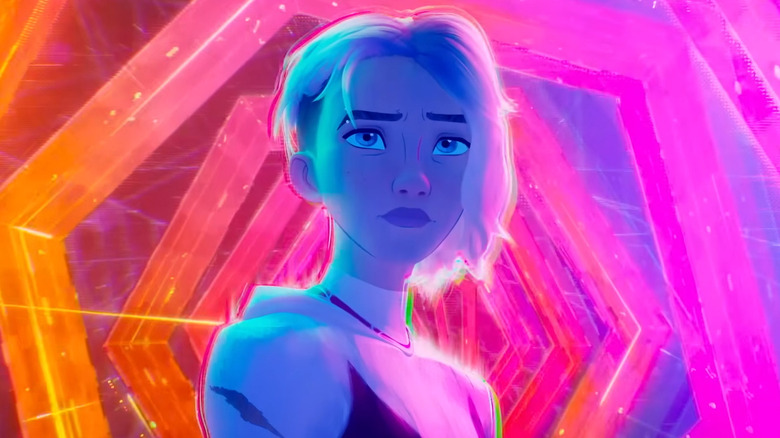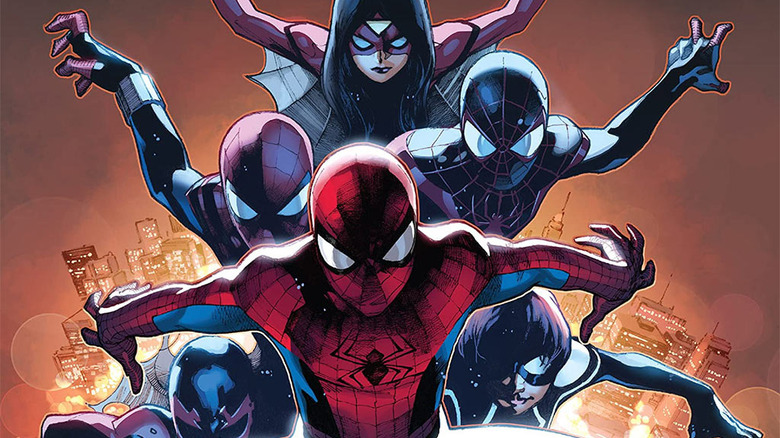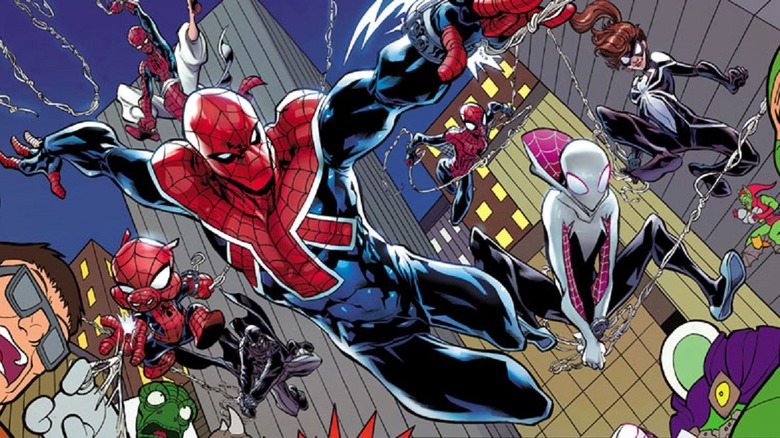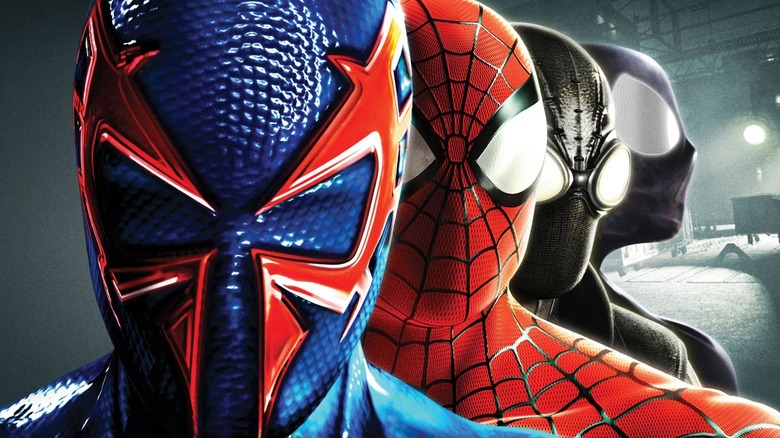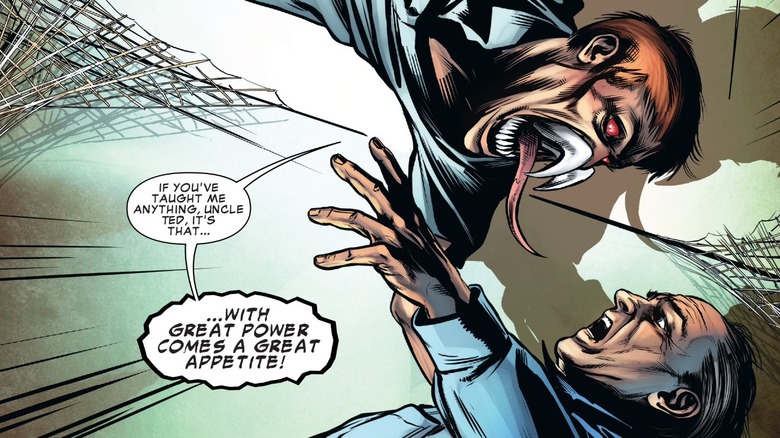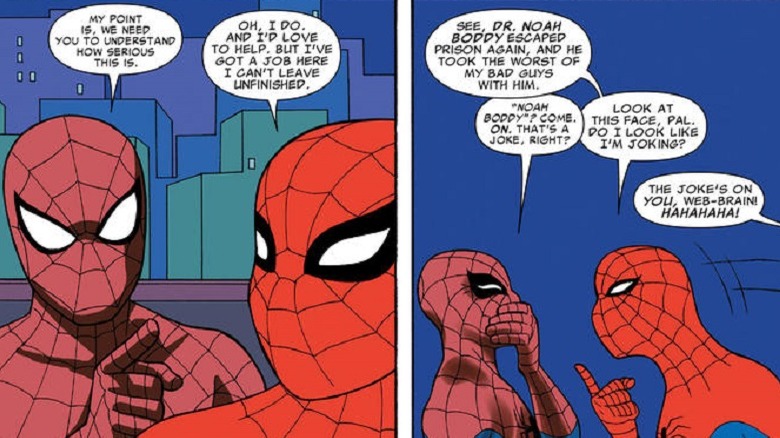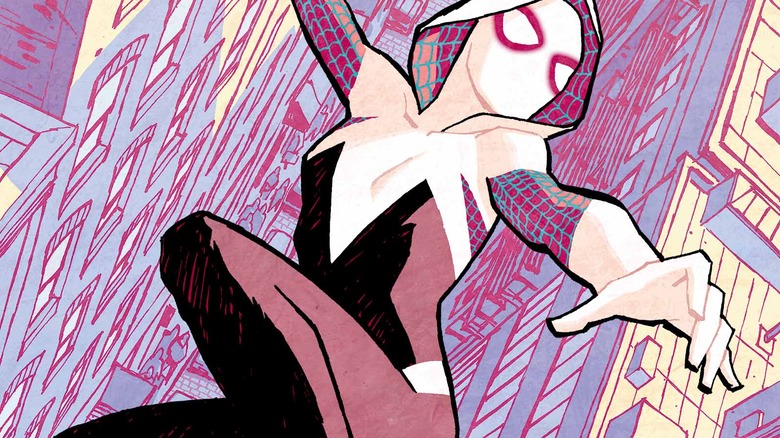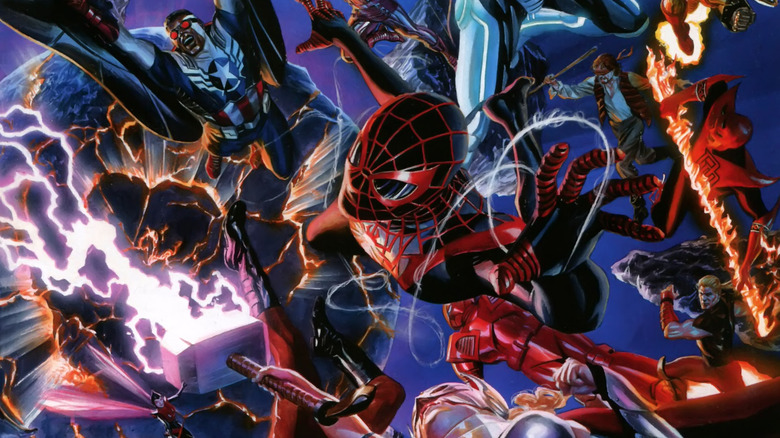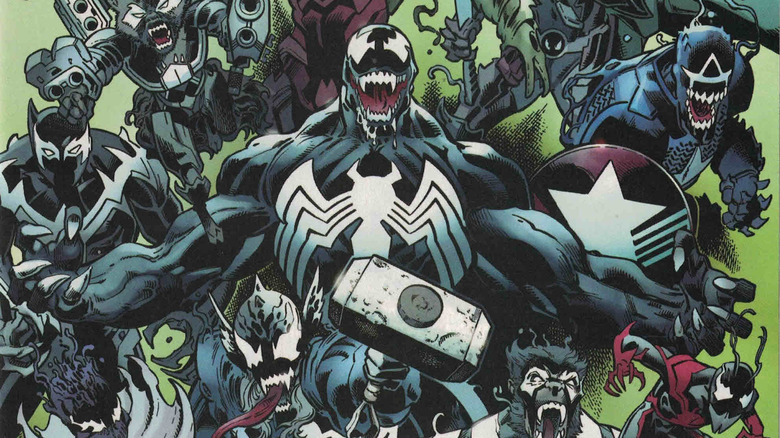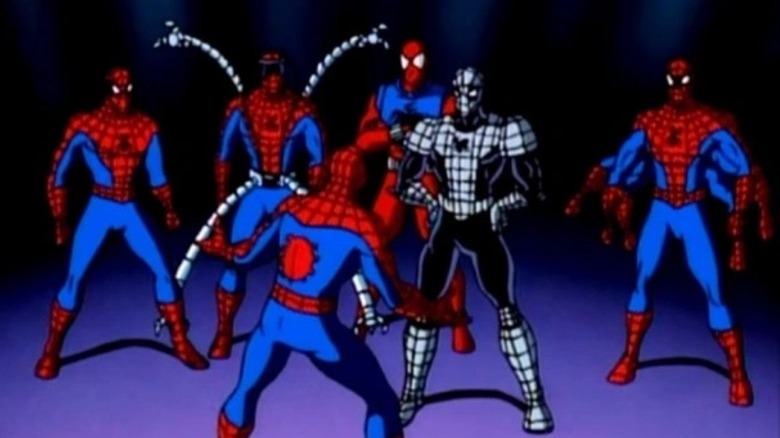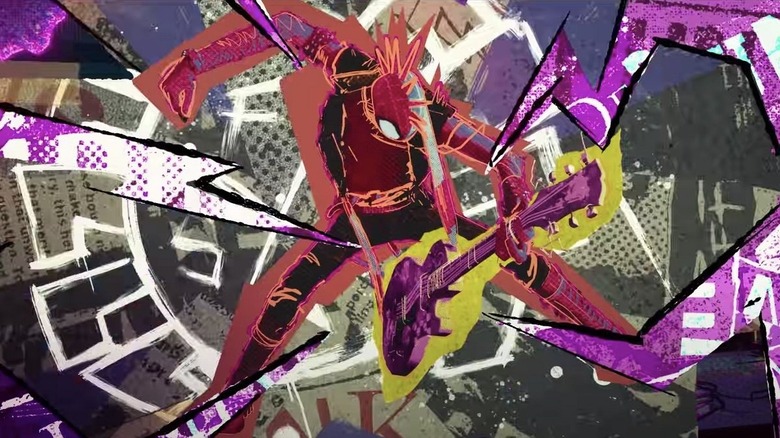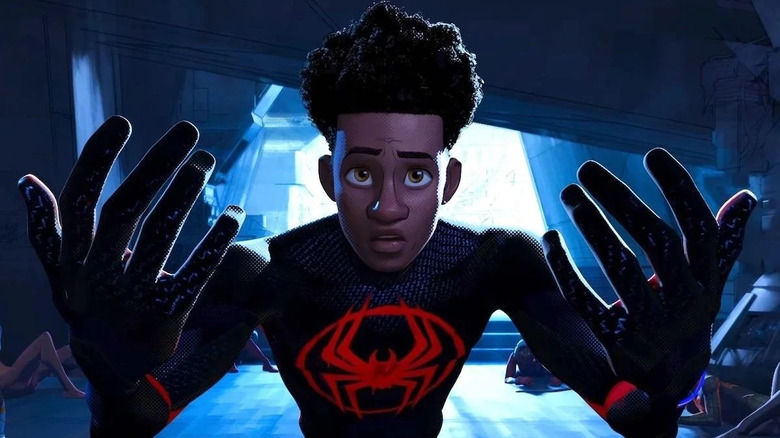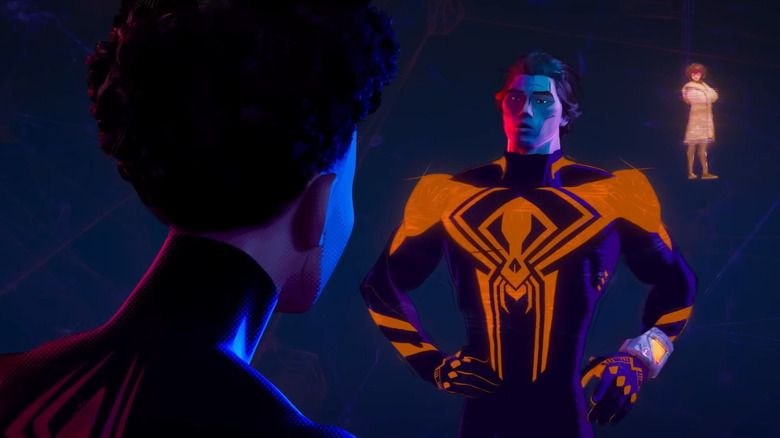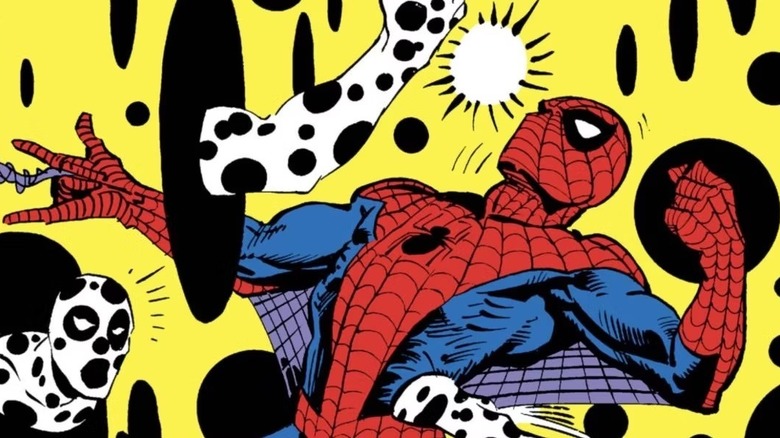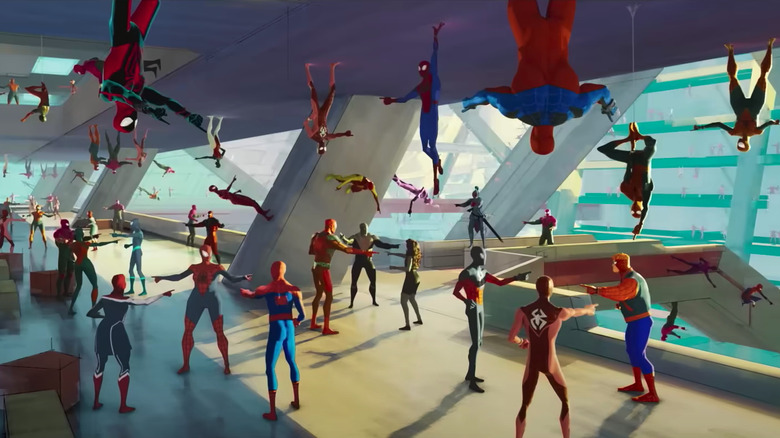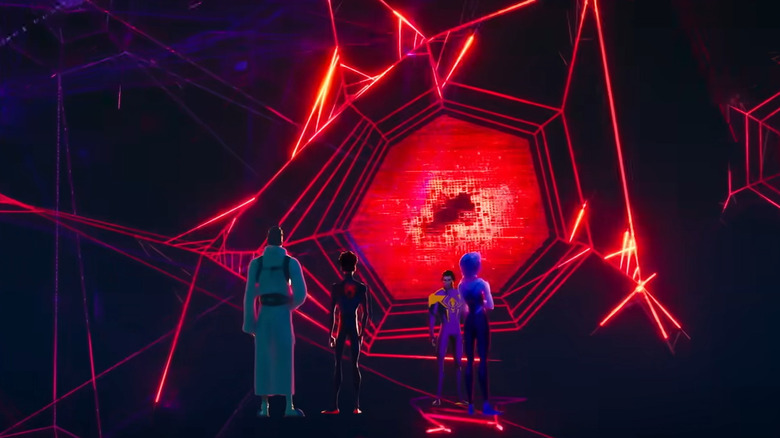The Untold Truth Of The Spider-Verse
"Spider-Man: Across the Spider-Verse" has finally arrived, and, with widespread critical acclaim, the film is yet another win for the wall crawler. The sequel takes everything that made "Spider-Man: Into the Spider-Verse" so good and cranks it up to 11, making for a thoroughly engrossing experience. The animation is stunning, the voice acting is perfect, and the creators take the story in some truly gonzo directions. These developments include the Spider-Verse itself, a concept that we were only given a small sample of in the first film.
This means that not only are we treated to more colorful and crazy Spider-people, but the mechanics of the Spider-Verse itself are expanded on. We're given a better insight into how many Spider-people there are and how they travel through the Spider-Verse. Miles Morales is truly put through the wringer in regard to his place in the Spider-Verse and where he belongs — or doesn't belong, as it turns out.
There's a lot of ground to cover, so mask up and grab your web shooters. From the hit movies to the comic books that inspired them and everything in between, this is the untold truth of the Spider-Verse.
Be warned, there are spoilers ahead!
Spider-Verse: The original comic
With all the buzz surrounding the latest entry in the "Spider-Verse" film franchise, it's important to remember where it all started. Released at the tail end of 2014, "Spider-Verse" was the biggest Spider-Man event comic up until that point. The story concerns a threat that brings together Spider heroes from across the multiverse. However, the plot in the comic differs to that of the movie, with an entirely different threat at the center of it.
The whole Spider-Verse is being targeted by Morlun and his ravenous family of fellow vampires. The essence they crave comes from different Spider-people, or "Spider-Totems." This means that Peter Parker, Miles Morales, Spider-Gwen, as well as a slew of new and old faces, are unfortunately on the menu.
This is not the case in "Into the Spider-Verse," which is predominantly focused on Miles with variants of Peter, Gwen and others joining in as the story progresses. The tone of the first film is also less grim than the comic, forgoing several sequences of Spider-men being harvested for their essence. The bones are similar but the first film definitely streamlines things immensely, saving more of the actual Spider-Verse for the second film.
Every Spider-Man ever
When "Spider-Verse" was announced, writer Dan Slott and editor Ben Morse promised the inclusion of "every Spider-Man in every universe," and that's exactly what they delivered.
A lot of the more prominent Spiders were familiar to Marvel fans. There was Miles Morales of the Ultimate Marvel Universe, Spider-Girl of the MC2 world where Peter Parker was her father, the gun-toting Peter Parker from "Spider-Man Noir," the future Spider-Man from the "2099" comics, the Bruce Banner Spider-Man from "Bullet Points," and of course the talking pig Spider-Ham from a world where Marvel's heroes are replaced with talking animals. At the same time there were plenty of soldier Spiders joining Parker from Earth-616 like Spider-Woman, a time-displaced Superior Spider-Man (Peter Parker's body with Doctor Octopus' mind), and the relatively new hero Silk.
But that was the tip of the iceberg. Along with all the known Spiders were hordes of new ones. An English Spider-Man, a cyborg Spider-Man, an assassin Spider-Man, a Spider-Punk (complete with metal spikes sticking out of the top of his mask), a werewolf Spider-Man, and even the Aunt May hero Spider-Ma'am. Yes. You read that correctly. Spider-Ma'am.
Most of the Spiders are killed and devoured by the Inheritors long before Spider-Man's army can find them; or even before it's formed. Even after the Spiders start working together, the body count grows. "Spider-Verse" is one of the most brutal Spider-Man stories you could read, and the pile of bodies stacks high.
Shattered Dimensions
While other artists and writers contributed to "Spider-Verse," the event was the brainchild of longtime Spider-Man writer Dan Slott. When Slott and editor Ben Morse announced the event, Slott revealed the inspiration for "Spider-Verse" was the 2010 video game "Spider-Man: Shattered Dimensions." Slott wrote the video game and he said he'd been working on "Spider-Verse" ever since.
In "Shattered Dimensions," the oracle character Madame Web recruits four versions of Spider-Man from different realities to retrieve an artifact that was smashed and scattered across their four worlds. There's the "regular" Earth-616 Spidey, Spider-Man from the year 2099, the black-clad Spider-Man of "Spider-Man Noir," and the Peter Parker from the Ultimate universe who was merged with a symbiote (Miles Morales would not assume the mantle of Spider-Man in the Ultimate comics for another year).
The different Spiders don't form any kind of team — instead working individually in their respective realities — but they are aware of the others and work in concert. It's easy to see how Slott used this as inspiration for a story with a much broader scope.
A celebration of comics
Like all big Marvel events, the point of "Spider-Verse" was to make money. But part of what made "Spider-Verse" unique was that more than a cash grab, it was a celebration of comics.
"Spider-Verse" was by no means the first comics event to deal with alternate realities and is in no danger of being the last, but Slott and company used the multiverse concept with a more metafictional bent. Much of the event's multiverse was made up of worlds inhabited in different genres of comics. For example, one world had the Spider-Man of the daily newspaper strips. Morlun attacks Parker and Mary Jane while they're at a picnic, and the villain gets frustrated with the dialogue. Because the strip was only a few panels, Parker repeats all of his dialogue every few panels (so readers would remember what happened the following day), and the Inheritor can't figure out what's going on. In another, more darkly hilarious example, Morlun hunts and kills the Spider-Man who used to appear in print ads for Twinkies and Hostess Pies. It ends with Spider-Man dead, and Morlun saying, "What a sweet and succulent soul you have! The greatest snack of all!"
One of the more well executed examples came in "Edge of Spider-Verse" #4, with a cover and content that was more horror comic than super-hero. Its protagonist didn't become a hero, but instead terrorized and murdered most of the people in his life, only to be consumed at the end by the Inheritors.
Beyond the panels
Wonderfully, while "Spider-Verse" celebrated comics, that doesn't mean it stopped with comics. When Slott said the event would include every Spider-Man ever, he apparently meant it, and he didn't just mean the ones appearing in panels. A moment in "Spider-Verse" that manages to be both hilarious and absolutely soul-crushing comes in "Amazing Spider-Man" #7 when Morlun kills the Spider-Man of the '80s cartoon "Spider-Man & His Amazing Friends." His buddies Iceman and Firestar get taken out too, and the scene ends with Firestar's dog Ms. Lion, whining helplessly among her friends' corpses.
But Slott doesn't stop with the eighties. In "Spider-Verse Team-Up" #2, Earth-616 Spider-Man and Miles Morales make a new friend — the much goofier Spider-Man of the 1967 animated series who deals with villains like Dr. Noah Boddy. The creators play with the differences between versions of the character by making the more contemporary Peter Parker doubt his alternate from the '60s is taking things seriously enough. The '60s Spider-Man has also been used as a recurring gag in the two "Spider-Verse" movies, brought to life with fittingly chintzy animation and voice acting.
Additionally, both the comics and the movies have made some nods to Toei's Japanese version of Spider-Man from the 1970s. In fact, in "Across the Spider-Verse," all the members of the Spider-Society wear wrist devices very similar in design to one worn by the Japanese Spidey. References like this are always appreciated because Spider-Man is truly one of fiction's most enduring characters, having been retooled time and time again. Whatever way you first discovered the character might be completely different from how someone else did.
Spider-Gwen
The only alternate Spider to be introduced in "Spider-Verse" to subsequently get a regular monthly series is the Gwen Stacy Spider-Woman or, as it says on the cover of her comic, "Spider-Gwen."
First appearing in "Edge of Spider-Verse" #2, Spider-Gwen is a mash-up of the traditional Spider-Man and Peter Parker's love interest Gwen Stacy whose death in 1973's "Amazing Spider-Man" #121 is often cited as one of the moments that ended the Silver Age of comics and started bringing superhero stories to darker and more mature places. But in Spider-Gwen's world, she never died because it was Gwen, not Parker, who was bitten by a radioactive spider. In the meantime, her world's version of Peter Parker grew so isolated that he eventually became The Lizard, and died in battle with Gwen.
Spider-Gwen was already a Marvel fixture prior to the "Spider-Verse" movies. She's shown up in the animated series "Spider-Man" and "Ultimate Spider-Man," and is playable in eight different video games including "Marvel: Contest of Champions," "Marvel: Future Fight," and "LEGO Marvel Super-Heroes 2."
Secret Wars
While "Spider-Verse" didn't really spill into any comics outside of Spider-Man's stable of titles, its narrative impact was felt all across Marvel. It was one of the major events to contribute to the cataclysmic "Last Days" event, and the resulting "Secret Wars" that ended all of Marvel's regular titles temporarily.
It was revealed in Marvel's "Age of Ultron" event that the constant tampering with the timeline and alternate realities by comic book heroes and villains was causing serious damage to the fabric of the universe, and that damage was what helps lead to the end of the Marvel Universe in "Last Days."
One character in particular directly contributes to this universal Armageddon. Spider-Man's army included a time-displaced Superior Spider-Man — Peter Parker's body usurped by the mind of Doctor Octopus. At this point Peter Parker had already regained control and Octopus had heroically sacrificed himself, but Ock didn't know that yet. When, after the defeat of the Inheritors, Superior Spider-Man learns what's in store, he isn't happy about it.
The final battle against the Inheritors takes place near the Web of Life and Destiny. When he learns of his fate, Superior Spider-Man begins to physically tear the Web apart, literally changing time and reality with his bare hands, hoping some of his destruction will break the strand of time that leads to his death. The other Spiders stop him, but the damage was already done.
Venomverse
Not to be outdone by his oldest rival, Venom — who had just been reunited with host Eddie Brock — had his own alternate reality event: 2017's "Venomverse." Like "Spider-Verse," the Venom event featured different versions of Venom from all over the multiverse. In the case of "Venomverse," we saw versions of the symbiote that had merged with other superheroes or supervillains. The Venoms banded together to protect each other from the Poisons — an alien race that was ruthlessly hunting all symbiotes and their hosts across the multiverse.
The event began with "Edge of Venomverse." Each issue featured tales of different heroes who had become Venom hosts, and each story ended with a Venomized Captain America appearing to recruit that hero into the war against the Poisons. When the main series "Venomverse" began, the allied symbiotes included the Eddie Brock Venom along with Venomized versions of Captain America, Ghost Rider, Deadpool, Rocket Raccoon, Doctor Strange, Ant-Man, X-23, and more.
"Vemonverse" spawned a sequel — 2018's "Venomized," which had the army of Poisons set their sights on Earth-616.
Echoes in other media
While the comic is where the term Spider-Verse originally appeared, this wasn't the first time different Spider-people collided. One of the first pieces of non-comic media to tackle the idea of a potential Spider-Verse was none other than "Spider-Man: The Animated Series." The beloved '90s cartoon served as an introduction to the wall crawling Marvel hero for many fans. It went above and beyond to pay tribute to the decades of comics that had come before it, never afraid to get a bit weird along the way.
Case in point: The two-part series finale "Spider Wars," in which Peter Parker meets a few other Spider-men from across the multiverse. This includes the Scarlet Spider, a Spider-Man with six arms, and a Spider-Man with Doctor Octopus-like tentacles. The crossover even wraps up with Peter getting to meet an animated version of Stan Lee, voiced by the man himself in a lovely little cameo. The third and fourth seasons of the animated "Ultimate Spider-Man" featured stories heavily inspired by "Spider-Verse," and included characters like Miles Morales, Spider-Ham, Spider-Man 2099, and others.
Beyond television, "Spider-Verse" has been heavily featured in Marvel video games of the later 2010s. "Spider-Verse" was used for a mission in the social network game "Marvel: Avengers Alliance," and the mobile game "Spider-Man Unlimited" was based on the event's plot while being used specifically to promote the comics. Characters like Miles Morales and Spider-Gwen are featured in games like "Marvel: Future Fight" and "Marvel Contest of Champions." While "Spider-Verse" isn't mentioned specifically in the game, almost all of the most prominent "Spider-Verse" characters are playable in "LEGO Marvel Super-Heroes 2."
Animation and superheroes, a wonderful combination
To note that the animation style of the "Spider-Verse" movies is incredible almost goes without saying at this point. Enough articles have been written and enough videos have been made discussing their unique blend of styles and varying character designs. The first film's trippy visuals really made an impact on people, to the point where other movies have emulated it, most notably "Puss in Boots: The Last Wish" and "Teenage Mutant Ninja Turtles: Mutant Mayhem."
While both films definitely have more than enough substance underneath all the style, the style is most certainly the main attraction. "Into the Spider-Verse" set the stage with its crunchy, more rigid style of animation, a definite far cry from the Pixar style we've all become accustomed to. This made it possible for "Across the Spider-Verse" to up the ante in a big bag way, pushing the envelope with its mixed media even further.
Every major player in the film is imbued with their own unique presentation, even when it comes to the accompanying music. For example, only a few shots of Spider-Punk look the same, as his texture and color palette are always in flux due to his anarchist nature. This makes it possible for the film to capture the feel of the comics in a way that a live-action film simply can't replicate.
Miles Morales: The odd man out
"Across the Spider-Verse" goes in some truly unexpected and jaw dropping directions, especially when it comes to Miles Morales. When we first see Miles get bitten during "Into the Spider-Verse," it's clear that the culprit isn't a typical genetically altered spider, especially given that it's glitching out. However, this visual motif actually adds to one of the major reveals in the sequel, coming during the film's climax.
We learn that Miles is actually an anomaly and that the spider that bit him was ripped from another dimension by the Spot while he worked at Alchemax. Spider-Man 2099 even notes that Miles wasn't supposed to be bitten and that if he hadn't been, then his dimension's Peter would have lived. We also learn that Gwen Stacy and Peter B. Parker have both been aware of this since joining the Spider-Society, never knowing how to tell Miles the truth.
This means that, more so than any other variant of Spider-Man, Miles is actually a freak accident. As an added twist, because Miles was bitten, that means whoever the spider was meant for never got bitten and their world doesn't have a Spider-Man. So, when Miles lands in the wrong dimension, he sees that in this world, his dad is already dead and his alternate self has become The Prowler.
It's all connected
"Across the Spider-Verse" really goes the extra mile to connect itself not just to other Sony Spider-Man movies, but to the Marvel Cinematic Universe as well. In the film's hefty opening sequence, Spider-Man 2099 fills Gwen Stacy in on how she and Miles basically left a hole in the multiverse. We also learn that there were some other shenanigans due to the actions of "Doctor Strange and that little nerd back on Earth-199999," clearly referencing the events of "No Way Home." But it doesn't stop there.
Halfway through the film, the Spot pops his head into a few random universes, coming face-to-face with Mrs. Chen from the Sony "Venom" movies. We're also treated to a surprise cameo from Donald Glover as a version of the Prowler, held captive in the Spider-Society's base.
Later on, during Miguel's explanation of the Spider-Verse, we're given some highlights from classic comics and other Spider-Man movies. This includes archival footage of Captain Stacy's death from "The Amazing Spider-Man," featuring Andrew Garfield's version of Spider-Man. As an added bonus we even get an appearance from The Spectacular Spider-Man, animated in his trademark style and voiced by original voice actor Josh Keaton.
The Spot's spots explained
"Into the Spider-Verse" only gave viewers a small taste of how vast the Spider-Verse is, leaving the door of possibility wide open. While "Across the Spider-Verse" ends on a cliffhanger, the creators did at least give us a lot more info on the mechanics of the Spider-Verse. As teased during the post-credits scene in the first film, Spider-Man 2099 has developed technology to allow for safe interdimensional travel. This means that he, as well as all the other Spider-recruits, can travel to and from as many universes as they want without fear of glitching out.
However, it's not just the Spider-people who can cross dimensions, as the Spot learns that his holes can now achieve the same thing. After his first fight with Miles, Spot finds himself inside of, well, himself. He's now able to use his self-generated portals as inter-dimensional gateways. Confused? Allow us to explain.
Real name Jonathan Ohnn, the Spot was once a scientist who was hired by Kingpin to reproduce the powers of Cloak, a Marvel vigilante capable of channeling matter from the Darkforce dimension. Ohnn succeeded in opening up a portal to this dimension, but things didn't go as planned — he stepped through it, and when he returned, his body was covered in black spots that led to different dimensions. Both people and things can pass through them via what's referred to as the Spotted Dimension.
There are over a hundred Spider-Man variants in Across the Spider-Verse
One of the biggest additions in the sequel is the unveiling of the Spider-Society, a high tech base on Earth-928. Following the events of "Into the Spider-Verse" it seems as though Spider-Man 2099 has recruited almost every Spider-person under the sun. Not only that, he seems to be the leader, making sure that everyone follows the rules of the multiverse. Their base of operations is not only an impressive facility in terms of scale, but it also plays host to many of the film's best cameos. We get glimpses of different Spider-men and women, as well as some villains from past Spidey films and comics.
It's impressive how well the film is able to capture the style of the various Spider-variants on display here. For example, when the '60s cartoon Spidey swings by, it's a stiff and poorly animated drawing much like it'd be during that time period. There's also the Scarlet Spider, who, as a product of '90s comic books, has an overly dramatic monologue. The setting works perfectly as the film's big set piece, complete with over one hundred Spider-variants giving chase to Miles.
What are Canon Events in the Spider-Verse?
From the opening scene, "Across the Spider-Verse" opts to take things in a much more mature and intense direction. This shift in tone persists throughout the film, often subverting our expectations of a standard Spider-Man story. This is especially the case with Miles, whose place in the multiverse is called into question in the first act. We initially assume that the Spot, who Miles even calls a "villain of the week," isn't very important to the story. However, we later learn that it was the Spot who, while working at Alchemax, brought the spider that bit Miles into his dimension in the first place, changing the course of Spider-Verse history.
But it doesn't end there, as it turns out that all Spider-people have shared events throughout their stories known as canon events. These canon events are the connected threads that bind the Spider-Verse together, and if they are broken, a whole universe could fall apart. This means that every Spider-person is basically stuck in an existence where things have to go wrong in a never ending cycle. It's a harsh twist on the running joke that the story of Spider-Man can't work if he's happy.
